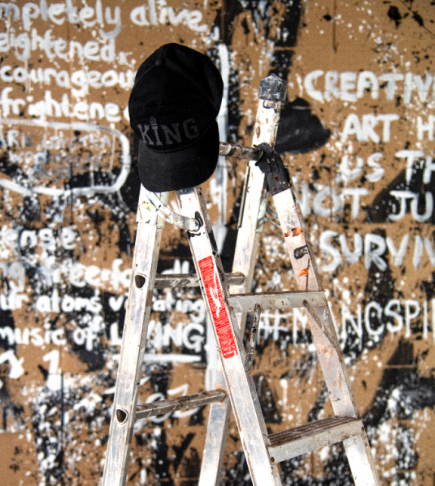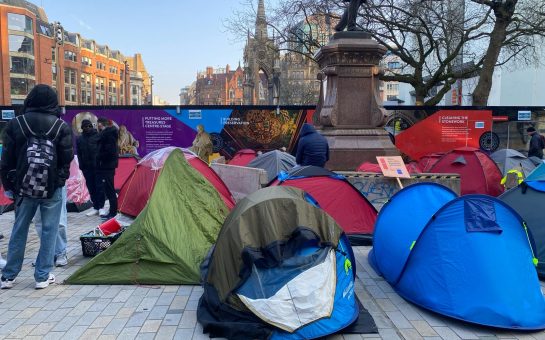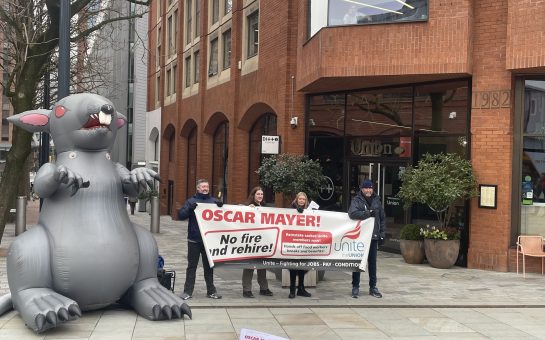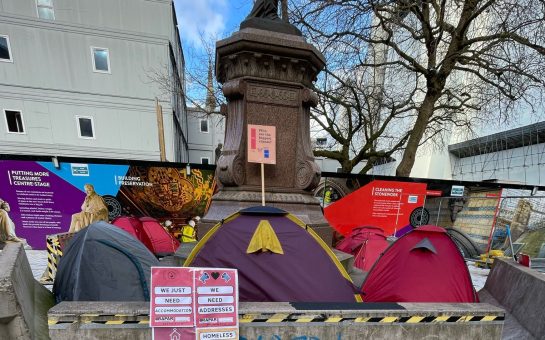You don’t have to be a statistician to know homelessness is rising in Manchester.
Charities like The Booth Centre, raising money this week during ‘The Manchester Sleepout’ event, run daily employment and skills sessions, helping those affected find a better future.
But in 2017, Karl Hyde and Rick Smith of Underworld sought to address the recovery process through a different approach – collective art production.
Premiering at the city’s International Festival, they created an installation showcasing the life stories of those who’d experienced homelessness and marginalisation.
Participants’ first-hand accounts, hand-painted on cardboard, aired the disparate reasons for their hardships and the strength they found to overcome them.
Now in its second year, we talked to senior project manager Simon Leroux about the organisation’s origins, the power of narratives and his hopes for the future.
What were Karl Hyde and Rick Smith initial guiding principles for Manchester Street Poem?
Their guiding principle was not simply to create an installation imposed on the city for a festival but to consider the work’s lasting legacy. Another strong focus was on co-production, where decisions would be made by a group of local people with professional and/or lived experience of homelessness. Karl’s statement to the co-production group at the beginning was that he was open to being “hijacked”.
Karl’s performance art and Rick’s beautifully crafted soundtrack offered stunning and sensitive additions to the stories we collected.
It felt like we were a big part in starting a conversation around art in recovery, which has continued to grow ever since. We now curate our content by running storytelling workshops, so that contributors can engage with the process right through to painting their own stories at installations.
Our core group has now grown to twenty active storytellers.
At the moment, we’re in the process of setting up Manchester Street Poem as a charity. Karl and Rick are still a big part of the team, but I think it’s fair to say the project has taken on a life of its own.
We’re not reliant on Underworld; at the same time, we know they’re there if we need them. It really does help to have someone with a profile in your corner in terms of opening doors and making a noise. It’s just a bonus that they’re bloody good blokes.
Governments and corporations often make arguments using statistical data. Why is storytelling an effective method for discussing homelessness and marginalisation?
Numbers don’t really tug on the heartstrings, do they? They also make it easier to “other” entire groups if they fall into this or that percentile.
Time consuming it may be, but we feel problems are better solved on an individual level rather than making sweeping statistical assumptions.
In the current climate, we believe it’s healthier to focus on what unites us than divides us. Storytelling is a great way to do that. Everyone can recognise something of the human condition in our stories and realise how close we all could be to “rock-bottom”.
You published a story about your own experiences of homelessness and marginalisation in Manchester. What was it like to air this in public?
For a long time, my past and present issues felt like things I had to keep as closely guarded secrets. They were faults, and they were failings.
They would serve no positive purpose if put out in the open. I’ve come to realise that often the act of keeping secrets can be more damaging than the issues themselves.
So now, I’ve spoken out in counselling, in group work, in writing, in short films, and in giant artworks posted in the centre of town. And you know what I’ve discovered about those faults and failings?
They’re actually strengths and experiences that have ultimately brought me to a pretty good place.

Do you find there are regional or national factors influencing homelessness and marginalisation in the city?
We see some recurring themes – broken families, drugs, alcohol, childhood abuse. But then we’ll have a storyteller who doesn’t fit into any of those boxes but has still found life collapsing around them.
What it comes down to for me is modern life has no margin for error. Unless you have independent wealth, you need to be firing on all cylinders just to make ends meet. You can’t afford a wobble, however short.
A brief spell of illness can result in debts, which will then spiral, further impacting health, and the whole thing snowballs. This can happen wherever you are on the pay scale.
Until we address how much we have to spend on the absolute basics as a proportion of income – water, heat, food, a roof overhead – we’ll continue to find new stories of marginalisation wherever we look.
How does Manchester Street Poem’s collaborations with local charities, including Mustard Tree, The Booth Centre and Back on Track, work in practice?
It’s important to be clear that Manchester Street Poem isn’t a support service. We work with people with a range of complex needs and have to be sure that they are accessing the support they need elsewhere.
We wouldn’t stick a mic in the face of a rough sleeper, high on spice, and ask them to give us their story. It wouldn’t be ethical, and we wouldn’t be equipped to support them.
Instead, we identify suitable contributors by working in partnership with established support services based in the city.
An effective Manchester Street Poem contributor will have already taken some positive steps towards improving their lives, and their engagement with external services is a fair indicator of this.
In July, you created an installation and temporary city-centre workshop for the Manchester International Festival (MIF). What did you set out to achieve with this work?
Our main installation was a billboard-sized work in Albert Square, which changed every day for 13 days.
The aim was to keep raising our profile and have more people hear our stories. 165,000 people came through Albert Square during the festival, and if just one in ten engaged with our work, it would represent a massive achievement for us.
We had storytellers posted at the square to answer questions and have conversations, and we decided to open the workshop where we created the billboards to the public, because you can’t have too many spaces for questions and conversations in our view.
Everyone we spoke to was so positive about the project and really keen to find out more. It was a truly transformative experience for our storytellers, many of whom grew in confidence and self-esteem before my eyes.
Moving forward, I’ve just come back from Japan with a view to exploring potential collaborations for an installation piece at an arts festival, staged alongside the 2020 Tokyo Olympics.
Nothing’s set in stone, but we made links with some incredible organisations out there. I also feel that our relationship with MIF could continue to flourish as they move into their new factory building.
How can people get involved with Manchester Street Poem?
All our stories can be heard or read on our website (mcrstreetpoem.com). There’s also a link where in return for a donation of five pounds or more, you can receive a download of our original Underworld installation score.
You can also follow us on Twitter and Instagram (@mcrstreetpoem), where you’ll be kept up to date with what we’re up to.
Anyone who wants to tell their story, and who’s prepared for the commitment involved, can get in touch through Instagram, Twitter or email ([email protected])



